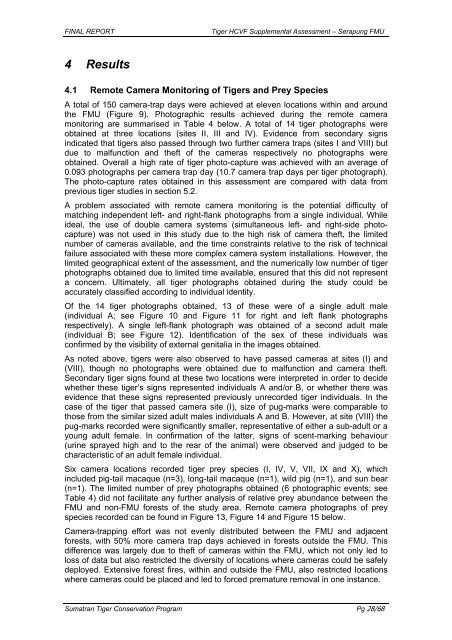A Supplemental HCVF Assessment on the Sumatran Tiger ...
A Supplemental HCVF Assessment on the Sumatran Tiger ...
A Supplemental HCVF Assessment on the Sumatran Tiger ...
Create successful ePaper yourself
Turn your PDF publications into a flip-book with our unique Google optimized e-Paper software.
FINAL REPORT <strong>Tiger</strong> <str<strong>on</strong>g>HCVF</str<strong>on</strong>g> <str<strong>on</strong>g>Supplemental</str<strong>on</strong>g> <str<strong>on</strong>g>Assessment</str<strong>on</strong>g> – Serapung FMU<br />
4 Results<br />
4.1 Remote Camera M<strong>on</strong>itoring of <strong>Tiger</strong>s and Prey Species<br />
A total of 150 camera-trap days were achieved at eleven locati<strong>on</strong>s within and around<br />
<strong>the</strong> FMU (Figure 9). Photographic results achieved during <strong>the</strong> remote camera<br />
m<strong>on</strong>itoring are summarised in Table 4 below. A total of 14 tiger photographs were<br />
obtained at three locati<strong>on</strong>s (sites II, III and IV). Evidence from sec<strong>on</strong>dary signs<br />
indicated that tigers also passed through two fur<strong>the</strong>r camera traps (sites I and VIII) but<br />
due to malfuncti<strong>on</strong> and <strong>the</strong>ft of <strong>the</strong> cameras respectively no photographs were<br />
obtained. Overall a high rate of tiger photo-capture was achieved with an average of<br />
0.093 photographs per camera trap day (10.7 camera trap days per tiger photograph).<br />
The photo-capture rates obtained in this assessment are compared with data from<br />
previous tiger studies in secti<strong>on</strong> 5.2.<br />
A problem associated with remote camera m<strong>on</strong>itoring is <strong>the</strong> potential difficulty of<br />
matching independent left- and right-flank photographs from a single individual. While<br />
ideal, <strong>the</strong> use of double camera systems (simultaneous left- and right-side photocapture)<br />
was not used in this study due to <strong>the</strong> high risk of camera <strong>the</strong>ft, <strong>the</strong> limited<br />
number of cameras available, and <strong>the</strong> time c<strong>on</strong>straints relative to <strong>the</strong> risk of technical<br />
failure associated with <strong>the</strong>se more complex camera system installati<strong>on</strong>s. However, <strong>the</strong><br />
limited geographical extent of <strong>the</strong> assessment, and <strong>the</strong> numerically low number of tiger<br />
photographs obtained due to limited time available, ensured that this did not represent<br />
a c<strong>on</strong>cern. Ultimately, all tiger photographs obtained during <strong>the</strong> study could be<br />
accurately classified according to individual identity.<br />
Of <strong>the</strong> 14 tiger photographs obtained, 13 of <strong>the</strong>se were of a single adult male<br />
(individual A; see Figure 10 and Figure 11 for right and left flank photographs<br />
respectively). A single left-flank photograph was obtained of a sec<strong>on</strong>d adult male<br />
(individual B; see Figure 12). Identificati<strong>on</strong> of <strong>the</strong> sex of <strong>the</strong>se individuals was<br />
c<strong>on</strong>firmed by <strong>the</strong> visibility of external genitalia in <strong>the</strong> images obtained.<br />
As noted above, tigers were also observed to have passed cameras at sites (I) and<br />
(VIII), though no photographs were obtained due to malfuncti<strong>on</strong> and camera <strong>the</strong>ft.<br />
Sec<strong>on</strong>dary tiger signs found at <strong>the</strong>se two locati<strong>on</strong>s were interpreted in order to decide<br />
whe<strong>the</strong>r <strong>the</strong>se tiger’s signs represented individuals A and/or B, or whe<strong>the</strong>r <strong>the</strong>re was<br />
evidence that <strong>the</strong>se signs represented previously unrecorded tiger individuals. In <strong>the</strong><br />
case of <strong>the</strong> tiger that passed camera site (I), size of pug-marks were comparable to<br />
those from <strong>the</strong> similar sized adult males individuals A and B. However, at site (VIII) <strong>the</strong><br />
pug-marks recorded were significantly smaller, representative of ei<strong>the</strong>r a sub-adult or a<br />
young adult female. In c<strong>on</strong>firmati<strong>on</strong> of <strong>the</strong> latter, signs of scent-marking behaviour<br />
(urine sprayed high and to <strong>the</strong> rear of <strong>the</strong> animal) were observed and judged to be<br />
characteristic of an adult female individual.<br />
Six camera locati<strong>on</strong>s recorded tiger prey species (I, IV, V, VII, IX and X), which<br />
included pig-tail macaque (n=3), l<strong>on</strong>g-tail macaque (n=1), wild pig (n=1), and sun bear<br />
(n=1). The limited number of prey photographs obtained (6 photographic events; see<br />
Table 4) did not facilitate any fur<strong>the</strong>r analysis of relative prey abundance between <strong>the</strong><br />
FMU and n<strong>on</strong>-FMU forests of <strong>the</strong> study area. Remote camera photographs of prey<br />
species recorded can be found in Figure 13, Figure 14 and Figure 15 below.<br />
Camera-trapping effort was not evenly distributed between <strong>the</strong> FMU and adjacent<br />
forests, with 50% more camera trap days achieved in forests outside <strong>the</strong> FMU. This<br />
difference was largely due to <strong>the</strong>ft of cameras within <strong>the</strong> FMU, which not <strong>on</strong>ly led to<br />
loss of data but also restricted <strong>the</strong> diversity of locati<strong>on</strong>s where cameras could be safely<br />
deployed. Extensive forest fires, within and outside <strong>the</strong> FMU, also restricted locati<strong>on</strong>s<br />
where cameras could be placed and led to forced premature removal in <strong>on</strong>e instance.<br />
<strong>Sumatran</strong> <strong>Tiger</strong> C<strong>on</strong>servati<strong>on</strong> Program Pg 28/68

















